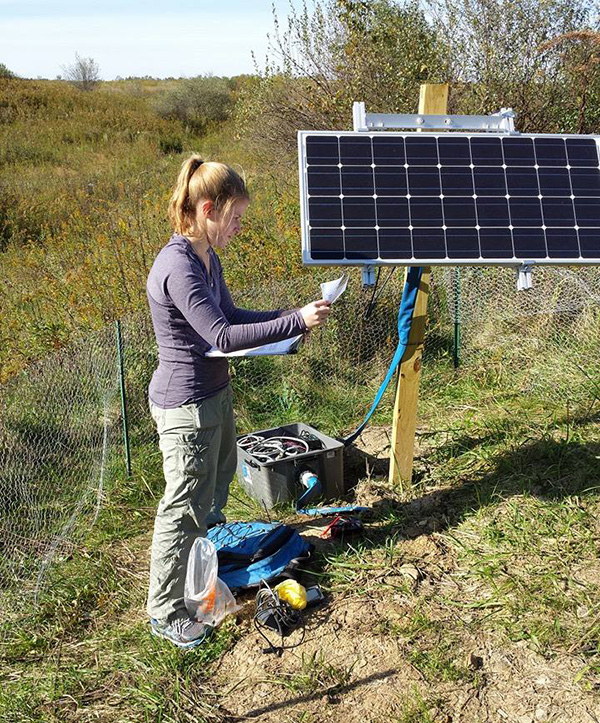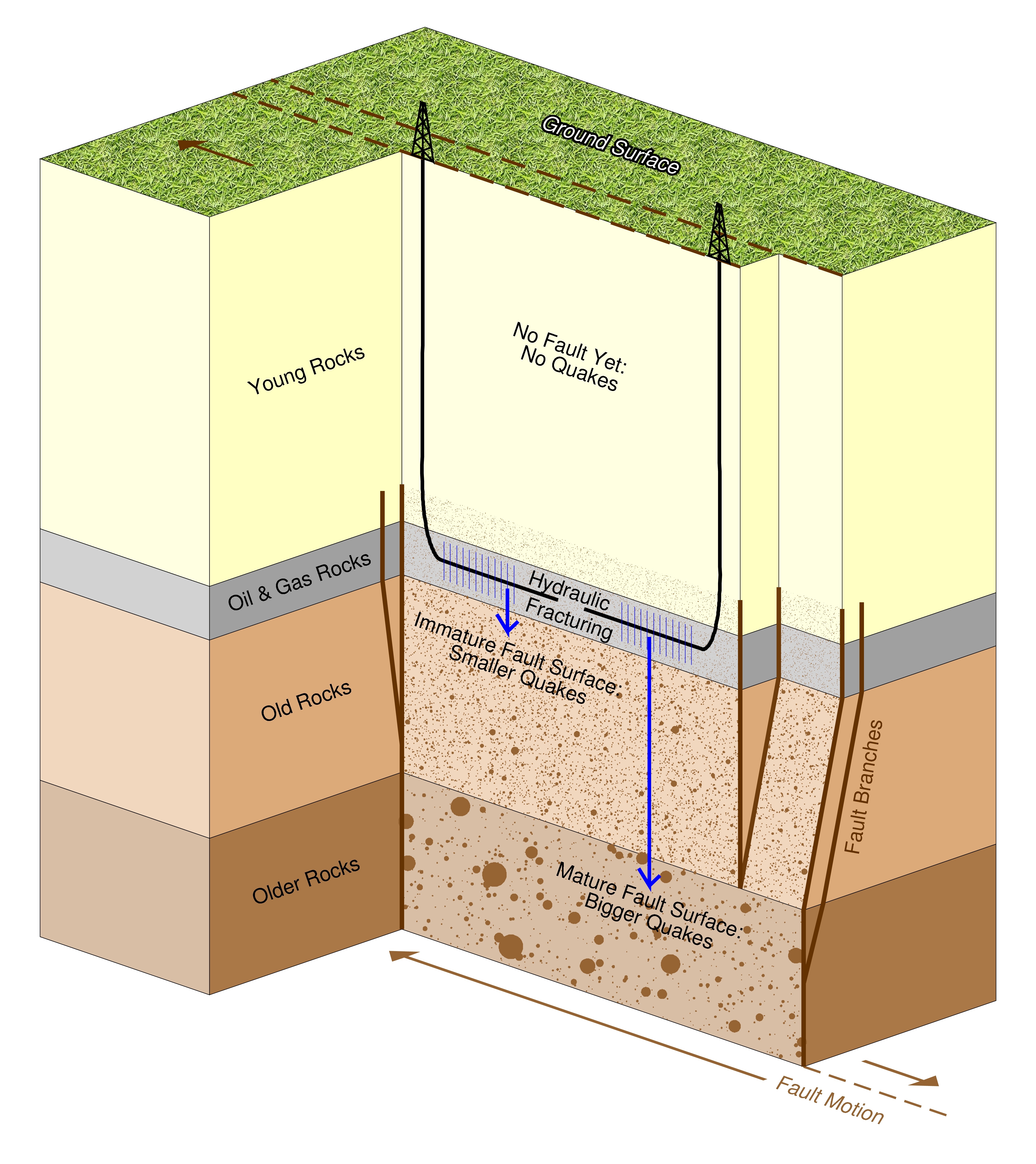
Geologists explore relationship of fracking and earthquakes in Ohio
Drilling for natural gas reveals previously unknown faults
By Greg Hand for Miami University
Miami University researchers have discovered the relationship between hydraulic fracturing and earthquakes is more complicated than previously believed. Their discoveries offer new insights into how natural gas extraction induces seismic activity.
As America’s supply of natural gas increasingly relies on hydraulic fracturing or “fracking,” concerns about earthquakes caused by this process have grown. Increased seismicity is usually blamed on the disposal of wastewater produced by fracking when it is pumped deep underground into rock containing geologic faults.
A new paper by the Miami scientists, published Feb. 5 in the Proceedings of the National Academy of Sciences, describes conditions under which the fracking process itself, not wastewater disposal, causes increased earthquake activity. By correlating many tremor recordings, the researchers found fracking caused seismicity at two distinct underground levels, each with different magnitude patterns, revealing new clues about how buried faults behave.
Authors of the paper are Maria Kozlowska, a former post-doctoral fellow at Miami, Miami geology professors Michael Brudzinski and Brian Currie; Paul Friberg of Instrumental Software Technologies Inc.; Robert J. Skoumal ’16 (then a doctoral candidate); and Nicholas Baxter ’17 (then a junior geology major).

This diagram shows that hydraulic fracturing occurs miles below the earth's surface and that sometimes it occurs near a fault where rocks slip past each other. The age of the fault surfaces below the oil and gas rocks makes a difference in the intensity of a potential earthquake shown as brown circles. The blue arrows show some wells disturb the shallower, immature part of the fault and some wells disturb the deeper, mature part of the fault.
“We can use frequency-magnitude characteristics as an initial indicator for seismic hazard in the area,” Kozlowska said. “Stronger, deeper earthquakes occurring on old preexisting faults show different characteristics than smaller events occurring closer to the shale formation from which the natural gas is extracted.”
The new findings resulted from the study of earthquake patterns in eastern Ohio. These earthquakes originate in previously unknown faults buried deep in the bedrock.
Stored energy awakens
“The faults we found that produced the earthquakes were most likely generated hundreds of millions of years ago when plates were colliding into eastern North America and generating the Appalachian Mountains,” Brudzinski said. “But things settled down millions of years ago along the East Coast and the lack of tectonic activity means the fault movements have slowed to nearly a stop. We think that the injection has awakened them by allowing stored energy from long ago to finally be released.”
Beneath Harrison County near the Pennsylvania border a layer of soft sedimentary rock known as shale contains a supply of natural gas that can be extracted by pumping highly pressurized water into the subterranean formation, fracturing the rock and allowing the gas to escape. This layer of gas-yielding shale lies atop deeply buried igneous rock that forms a sort of geologic “basement.”
Because hydraulic fracturing uses immense volumes of pressurized water to extract natural gas, the process results in large quantities of polluted wastewater that is generally pumped into very deep underground reservoirs for disposal. Earthquakes have generally been blamed on wastewater disposal.
“We focused instead on less common cases where hydraulic fracturing alone has caused earthquakes,” Kozlowska said. “We found this seismicity separated into two depth zones: a shallow zone on younger faults with more small-magnitude earthquakes than expected, and a deeper zone on older faults with larger-magnitude earthquakes and seismicity continuing after fracturing stops. Hence, inducing deeper seismicity creates more hazard.”
With this information, researchers can better advise environmental regulators as well as natural gas companies about what to expect when attempting hydraulic fracturing in certain areas, Brudzinski said.
The earthquakes studied by the Miami University team, although numerous and frequent, were mostly very small and generally would not have been noticed by nearby residents. Instruments installed in Harrison County by the Ohio Department of Natural Resources, Miami University, and the National Science Foundation EarthScope program provided the data for analysis.

Shannon Fasola, (Miami MS 2016) doctoral student in geology, is director of Miami's seismic deployments. She is at a seismometer southwest of Harrison County, Ohio.
"At first we didn't expect to receive such interesting results; we simply wanted to locate the seismicity. We then found that this particular case shows features that were not observed before,” Kozlowska said.
Specifically, the Miami researchers found strong evidence that the more deeply buried igneous rock formations contained more mature faults than the younger sedimentary rocks where the fracking operations actually take place. While fracking activity occurs in these shallow layers, it very rapidly causes earthquakes among deeper, mature faults.
“The earthquakes we have been studying show patterns that indicate the operations are re-activating old faults instead of creating new ones,” Brudzinski said. “In most cases, the faults we are seeing re-activated have the same type of orientation that is aligned with the overall stress field in the Earth’s crust. We say these faults are ‘optimally oriented,’ and they should have the largest stresses placed on them naturally. This means they would be stressed to a critical point such that only small changes in conditions (like that from fluid injection) would cause them to move.”
Support for this research was provided by the National Science Foundation, a Kosciuszko Foundation grant in support of Kozlowska’s post-doctoral fellowship, and the Ohio Department of Natural Resources Geologic Survey.
